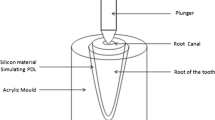Abstract
Objectives
To investigate the effect of a zinc oxide/zinc sulphate-based cement as a temporary filling material during root canal treatment on the occurrence of cracks within the filling material or the tooth.
Materials and methods
Root canals of 122 extracted human molars were prepared using ProTaper instruments. Standardized occlusal-distal cavities were prepared. After placing calcium hydroxide into the root canals, the teeth were divided randomly into four groups containing 33 specimens each. In the Coltosol group, the cavity was completely filled with Coltosol® F. In the Coltosol-Clearfil group, a 2-mm layer of Coltosol® F was placed into the apical part of the pulp chamber, and in the Clearfil group, a foam pellet was placed into the coronal pulp chamber. The remaining cavities were filled with Clearfil™. In the control group, the cavities were not restored. The teeth were stored at 37 °C for 14 days and examined every 24 h under a stereomicroscope.
Results
Fractures of the filling and/or the tooth were only observed in the Coltosol group. All Coltosol® F restorations had cracks after 24 h. Tooth fractures were found in 25 (76 %) teeth. Among these teeth, 21 (84 %) had crown fractures, four (16 %) had root-crown fractures. All root-crown fractures were vertical.
Conclusion
Coltosol® F when used alone led to tooth fractures in two-surface class II cavities in teeth undergoing root canal treatment.
Clinical relevance
Coltosol® F solely used as restorative material may lead to tooth fractures in two-surface class II cavities.



Similar content being viewed by others
References
Lynch CD, Burke FM, Ni Riordain R, Hannigan A (2004) The influence of coronal restoration type on the survival of endodontically treated teeth. Eur J Prosthodont Restor Dent 12:171–176
Zmener O, Banegas G, Pameijer CH (2004) Coronal microleakage of three temporary restorative materials: an in vitro study. J Endod 30:582–584
Naseri M, Ahangari Z, Shahbazi Moghadam M, Mohammadian M (2012) Coronal sealing ability of three temporary filling materials. Iran Endod J 7:20–24
Madarati A, Rekab MS, Watts DC, Qualtrough A (2008) Time-dependence of coronal seal of temporary materials used in endodontics. Aust Endod J 34:89–93
Laustsen MH, Munksgaard EC, Reit C, Bjorndal L (2005) A temporary filling material may cause cusp deflection, infractions and fractures in endodontically treated teeth. Int Endod J 38:653–657
Tennert C, Eismann M, Goetz F, Woelber JP, Hellwig E, Polydorou O (2014) A temporary filling material used for coronal sealing during endodontic treatment may cause tooth fractures in large class II cavities in vitro. Int Endod J. doi:10.1111/iej.12280
Burke FJ, Palin WM, James A, Mackenzie L, Sands P (2009) The current status of materials for posterior composite restorations: the advent of low shrink. Dent Update 36:401–409
Soros C, Zinelis S, Lambrianidis T, Palaghias G (2008) Spreader load required for vertical root fracture during lateral compaction ex vivo: evaluation of periodontal simulation and fracture load information. Oral Surg Oral Med Oral Pathol Oral Radiol Endodontol 106:64–70
Howe CA, McKendry DJ (1990) Effect of endodontic access preparation on resistance to crown-root fracture. J Am Dent Assoc 121:712–715
Yassen GH, Vail MM, Chu TG, Platt JA (2013) The effect of medicaments used in endodontic regeneration on root fracture and microhardness of radicular dentine. Int Endodod J 46:688–695
Zarei M, Afkhami F, Malek Poor Z (2013) Fracture resistance of human root dentin exposed to calcium hydroxide intervisit medication at various time periods: an in vitro study. Dent Traumatol 29:156–160
Ten Cate AR, Mills C (1972) The development of the periodontium: the origin of alveolar bone. Anat Rec 173:69–77. doi:10.1002/ar.1091730106
Ratcliff S, Becker IM, Quinn L (2001) Type and incidence of cracks in posterior teeth. J Prosthet Dent 86:168–172
Udoye CI, Jafarzadeh H (2009) Cracked tooth syndrome: characteristics and distribution among adults in a Nigerian teaching hospital. J Endod 35:334–336
Cobankara FK, Unlu N, Cetin AR, Ozkan HB (2008) The effect of different restoration techniques on the fracture resistance of endodontically-treated molars. Oper Dent 33:526–533
Cameron CE (1976) The cracked tooth syndrome: additional findings. J Am Dent Assoc 93:971–975
Seo DG, Yi YA, Shin SJ, Park JW (2012) Analysis of factors associated with cracked teeth. J Endod 38:288–292
Daneshkazemi AR (2004) Resistance of bonded composite restorations to fracture of endodontically treated teeth. J Contemp Dent Pract 5:51–58
Acknowledgments
The authors want to thank Mrs. Dr. M. Baechle-Haas for the support in photographing the specimens and Dr. Falko Goetz for the support in designing the project.
Conflicts interest
The authors declare that they have no competing interests.
Author information
Authors and Affiliations
Corresponding author
Rights and permissions
About this article
Cite this article
Tennert, C., Fischer, G.F., Vach, K. et al. A temporary filling material during endodontic treatment may cause tooth fractures in two-surface class II cavities in vitro. Clin Oral Invest 20, 615–620 (2016). https://doi.org/10.1007/s00784-015-1543-z
Received:
Accepted:
Published:
Issue Date:
DOI: https://doi.org/10.1007/s00784-015-1543-z




